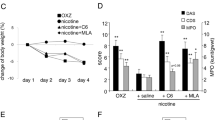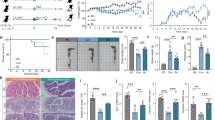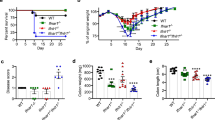Abstract
Ulcerative colitis (UC) is a chronic inflammatory disease of the gastrointestinal tract, which is closely related to gut barrier dysfunction. Emerging evidence shows that interleukin-22 (IL-22) derived from group 3 innate lymphoid cells (ILC3s) confers benefits on intestinal barrier, and IL-22 expression is controlled by aryl hydrocarbon receptor (AhR). Previous studies show that baicalein protects the colon from inflammatory damage. In this study we elucidated the molecular mechanisms underlying the protective effect of baicalein on intestinal barrier function in colitis mice. Mice were administered baicalein (10, 20, 40 mg·kg−1·d−1, i.g.) for 10 days; the mice freely drank 3% dextran sulfate sodium (DSS) on D1–D7 to induce colitis. We showed that baicalein administration simultaneously ameliorated gut inflammation, decreased intestinal permeability, restored tight junctions of colons possibly via promoting AhR/IL-22 pathway. Co-administration of AhR antagonist CH223191 (10 mg/kg, i.p.) partially blocked the therapeutic effects of baicalein in colitis mice, whereas AhR agonist FICZ (1 μg, i.p.) ameliorated symptoms and gut barrier function in colitis mice. In a murine lymphocyte line MNK-3, baicalein (5–20 μM) dose-dependently increased the expression of AhR downstream target protein CYP1A1, and enhanced IL-22 production through facilitating AhR nuclear translocation, these effects were greatly diminished in shAhR-MNK3 cells, suggesting that baicalein induced IL-22 production in AhR-dependent manner. To further clarify that, we constructed an in vitro system consisting of MNK-3 and Caco-2 cells, in which MNK-3 cell supernatant treated with baicalein could decrease FITC-dextran permeability and promoted the expression of tight junction proteins ZO-1 and occluding in Caco-2 cells. In conclusion, this study demonstrates that baicalein ameliorates colitis by improving intestinal epithelial barrier via AhR/IL-22 pathway in ILC3s, thus providing a potential therapy for UC.
Similar content being viewed by others
Login or create a free account to read this content
Gain free access to this article, as well as selected content from this journal and more on nature.com
or
References
Piovani D, Danese S, Peyrin-Biroulet L, Nikolopoulos GK, Lytras T, Bonovas S. Environmental risk factors for inflammatory bowel diseases: an umbrella review of meta-analyses. Gastroenterology. 2019;157:647–59. e4
Kobayashi T, Siegmund B, Le Berre C, Wei SC, Ferrante M, Shen B, et al. Ulcerative colitis. Nat Rev Dis Prim. 2020;6:74.
Mehandru S, Colombel JF. The intestinal barrier, an arbitrator turned provocateur in IBD. Nat Rev Gastroenterol Hepatol. 2021;18:83–4.
Eisenstein M. Gut reaction. Nature. 2018;563:S34–S5.
Odenwald MA, Turner JR. The intestinal epithelial barrier: a therapeutic target? Nat Rev Gastroenterol Hepatol. 2017;14:9–21.
Geng S, Cheng S, Li Y, Wen Z, Ma X, Jiang X, et al. Faecal microbiota transplantation reduces susceptibility to epithelial injury and modulates tryptophan metabolism of the microbial community in a piglet model. J Crohns Colitis. 2018;12:1359–74.
Lindemans CA, Calafiore M, Mertelsmann AM, O’Connor MH, Dudakov JA, Jenq RR, et al. Interleukin-22 promotes intestinal-stem-cell-mediated epithelial regeneration. Nature. 2015;528:560–4.
Gronke K, Hernandez PP, Zimmermann J, Klose CSN, Kofoed-Branzk M, Guendel F, et al. Interleukin-22 protects intestinal stem cells against genotoxic stress. Nature. 2019;566:249–53.
Qiu J, Zhou L. Aryl hydrocarbon receptor promotes RORγt+ group 3 ILCs and controls intestinal immunity and inflammation. Semin Immunopathol. 2013;35:657–70.
Gutierrez-Vazquez C, Quintana FJ. Regulation of the immune response by the aryl hydrocarbon receptor. Immunity. 2018;48:19–33.
Li J, Doty A, Glover SC. Aryl hydrocarbon receptor signaling involves in the human intestinal ILC3/ILC1 conversion in the inflamed terminal ileum of Crohn’s disease patients. Inflamm Cell Signal. 2016;3:e1404.
Yu K, Ma YH, Zhang ZC, Fan X, Li TM, Li LZ, et al. AhR activation protects intestinal epithelial barrier function through regulation of Par-6. J Mol Histol. 2018;49:449–58.
Mandal PK. Dioxin: a review of its environmental effects and its aryl hydrocarbon receptor biology. J Comp Physiol B. 2005;175:221–30.
Quintana FJ, Basso AS, Iglesias AH, Korn T, Farez MF, Bettelli E, et al. Control of Treg and TH17 cell differentiation by the aryl hydrocarbon receptor. Nature. 2008;453:65–71.
Liu TM, Jiang XH. Studies on the absorption kinetics of baicalin and baicalein in rats’ stomachs and intestines. China J Chin Mater Med. 2006;31:999–1001.
Shan H, Du YX, Bai HQ, Chen JX, He XL, Wang Q, et al. Progress in the development of baicalein and its clinical pharmacology study. Chin J Clin Pharmacol Ther. 2020;25:701–8.
Sheng A, Wu L, Zhu WF. Research progress on in vitro and in vivo transformation between baicalin and baicalin in Scutellaria baicalensis Georgi. Jiangxi. J Tradit Chin Med. 2017;48:71–4.
Zhong X, Surh YJ, Do SG, Shin E, Shim KS, Lee CK, et al. Baicalein inhibits dextran sulfate sodium-induced mouse colitis. J Cancer Prev. 2019;24:129–38.
Bae MJ, Shin HS, See HJ, Jung SY, Kwon DA, Shon DH. Baicalein induces CD4+ Foxp3+ T cells and enhances intestinal barrier function in a mouse model of food allergy. Sci Rep. 2016;6:32225.
Harada A, Sugihara K, Watanabe Y, Yamaji S, Kitamura S, Ohta S. Aryl hydrocarbon receptor ligand activity of extracts from 62 herbal medicines and effect on cytochrome p450 activity. Yakugaku Zasshi. 2015;135:1185–96.
Yang FC, Chiu PY, Chen Y, Mak TW, Chen NJ. TREM-1-dependent M1 macrophage polarization restores intestinal epithelium damaged by DSS-induced colitis by activating IL-22-producing innate lymphoid cells. J Biomed Sci. 2019;26:46.
Allan DS, Kirkham CL, Aguilar OA, Qu LC, Chen P, Fine JH, et al. An in vitro model of innate lymphoid cell function and differentiation. Mucosal Immunol. 2015;8:340–51.
Huang S, Fu Y, Xu B, Liu C, Wang Q, Luo S, et al. Wogonoside alleviates colitis by improving intestinal epithelial barrier function via the MLCK/pMLC2 pathway. Phytomedicine. 2020;68:153179.
Berg RD, Garlington AW. Translocation of certain indigenous bacteria from the gastrointestinal tract to the mesenteric lymph nodes and other organs in a gnotobiotic mouse model. Infect Immun. 1979;23:403–11.
Ambrose NS, Johnson M, Burdon DW, Keighley MR. Incidence of pathogenic bacteria from mesenteric lymph nodes and ileal serosa during Crohn’s disease surgery. Br J Surg. 1984;71:623–5.
Kiely CJ, Pavli P, O’Brien CL. The microbiome of translocated bacterial populations in patients with and without inflammatory bowel disease. Intern Med J. 2018;48:1346–54.
Grootjans J, Hundscheid IH, Lenaerts K, Boonen B, Renes IB, Verheyen FK, et al. Ischaemia-induced mucus barrier loss and bacterial penetration are rapidly counteracted by increased goblet cell secretory activity in human and rat colon. Gut. 2013;62:250–8.
Capaldo CT, Powell DN, Kalman D. Layered defense: how mucus and tight junctions seal the intestinal barrier. J Mol Med. 2017;95:927–34.
Ramos GP, Papadakis KA. Mechanisms of disease: inflammatory bowel diseases. Mayo Clin Proc. 2019;94:155–65.
Fang L, Pang Z, Shu W, Wu W, Sun M, Cong Y, et al. Anti-TNF therapy induces CD4+ T-cell production of IL-22 and promotes epithelial repairs in patients with Crohn’s disease. Inflamm Bowel Dis. 2018;24:1733–44.
Monteleone I, Rizzo A, Sarra M, Sica G, Sileri P, Biancone L, et al. Aryl hydrocarbon receptor-induced signals up-regulate IL-22 production and inhibit inflammation in the gastrointestinal tract. Gastroenterology. 2011;141:237–48.
Spits H, Artis D, Colonna M, Diefenbach A, Di Santo JP, Eberl G, et al. Innate lymphoid cells–a proposal for uniform nomenclature. Nat Rev Immunol. 2013;13:145–9.
Qiu J, Heller JJ, Guo XH, Chen ZME, Fish K, Fu YX, et al. The aryl hydrocarbon receptor regulates gut immunity through modulation of innate lymphoid cells. Immunity. 2012;36:92–104.
Zhou L. AHR function in lymphocytes: emerging concepts. Trends Immunol. 2016;37:17–31.
Cheng S, Shen H, Zhao S, Zhang Y, Xu H, Wang L, et al. Orally administered mesoporous silica capped with the cucurbit[8]uril complex to combat colitis and improve intestinal homeostasis by targeting the gut microbiota. Nanoscale. 2020;12:15348–63.
Lamas B, Richard ML, Leducq V, Pham HP, Michel ML, Da Costa G, et al. CARD9 impacts colitis by altering gut microbiota metabolism of tryptophan into aryl hydrocarbon receptor ligands. Nat Med. 2016;22:598–605.
Roager HM, Licht TR. Microbial tryptophan catabolites in health and disease. Nat Commun. 2018;9:3294.
Kiss EA, Diefenbach A. Role of the aryl hydrocarbon receptor in controlling maintenance and functional programs of ROR gamma t+ innate lymphoid cells and intraepithelial lymphocytes. Front Immunol. 2012;3:124.
Guo XH, Qiu J, Tu T, Yang XM, Deng LF, Anders RA, et al. Induction of innate lymphoid cell-derived interleukin-22 by the transcription factor STAT3 mediates protection against Intestinal Infection. Immunity. 2014;40:25–39.
Villarino AV, Sciume G, Davis FP, Iwata S, Zitti B, Robinson GW, et al. Subset-and tissue-defined STAT5 thresholds control homeostasis and function of innate lymphoid cells. J Exp Med. 2017;214:2999–3014.
Yang W, Yu T, Huang X, Bilotta AJ, Xu L, Lu Y, et al. Intestinal microbiota-derived short-chain fatty acids regulation of immune cell IL-22 production and gut immunity. Nat Commun. 2020;11:4457.
Bauche D, Joyce-Shaikh B, Fong J, Villarino AV, Ku KS, Jain R, et al. IL-23 and IL-2 activation of STAT5 is required for optimal IL-22 production in ILC3s during colitis. Sci Immunol. 2020; 5:eaav1080.
Wang CK, Ye Z, Kijlstra A, Zhou Y, Yang PZ. Decreased expression of the aryl hydrocarbon receptor in ocular Behcet’s disease. Mediat Inflamm. 2014;2014:195094.
Liu C, Li Y, Chen Y, Huang S, Wang X, Luo S, et al. Baicalein restores the balance of Th17/Treg cells via aryl hydrocarbon receptor to attenuate colitis. Mediat Inflamm. 2020;2020:5918587.
Acknowledgements
This work was supported by the National Natural Science Foundation of China (Grant No. 82074092), Characteristic Innovation Project of Guangdong Provincial Universities (Grant No. 2020KTSCX026), “Double First-class” and High-level University Discipline Collaborative Innovation Team Project of Guangzhou University of Chinese Medicine (Grant No. 2021xk81), Natural Science Foundation of Guangdong Province (Grant no. 2021A1515012219) and Guangdong Provincial Bureau of Traditional Chinese Medicine (Grant no. 20181076).
Author information
Authors and Affiliations
Contributions
YYL performed experiments and wrote the article. XJW, YLS, QW, SWH, ZFP contributed to establishment and treatment of colitis mice model. YPC, JJL, MLZ, XQX, ZYW performed some cell studies. JYC analyzed and organized the data. LZ and XL designed ideas and edited the paper.
Corresponding authors
Ethics declarations
Competing interests
The authors declare no competing interests.
Rights and permissions
About this article
Cite this article
Li, Yy., Wang, Xj., Su, Yl. et al. Baicalein ameliorates ulcerative colitis by improving intestinal epithelial barrier via AhR/IL-22 pathway in ILC3s. Acta Pharmacol Sin 43, 1495–1507 (2022). https://doi.org/10.1038/s41401-021-00781-7
Received:
Accepted:
Published:
Issue Date:
DOI: https://doi.org/10.1038/s41401-021-00781-7
Keywords
This article is cited by
-
The aryl hydrocarbon receptor: a new frontier in male reproductive system
Reproductive Biology and Endocrinology (2025)
-
Ginseng exosomes modulate M1/M2 polarisation by activating autophagy and target IKK/IкB/NF-кB to alleviate inflammatory bowel disease
Journal of Nanobiotechnology (2025)
-
The Role of Lactiplantibacillus plantarum CGMCC9513 in Alleviating Colitis by Synergistic Enhancement of the Intestinal Barrier Through Modulating Gut Microbiota and Activating the Aryl Hydrocarbon Receptor
Probiotics and Antimicrobial Proteins (2025)
-
Advances in the role of baicalin and baicalein in colon cancer: mechanisms and therapeutic potential
Discover Oncology (2025)
-
Pharmacological properties of Polygonatum and its active ingredients for the prevention and treatment of cardiovascular diseases
Chinese Medicine (2024)



